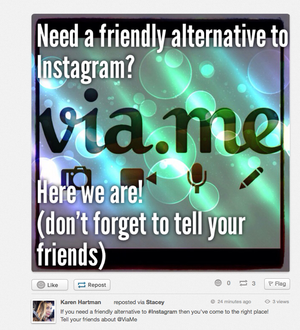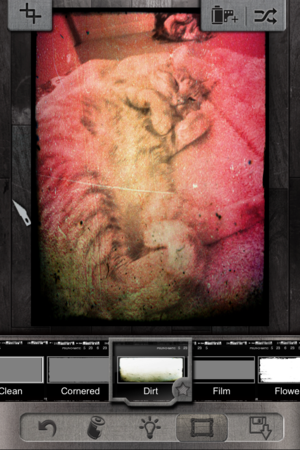Instagram updated its privacy policy terms of service on Monday, which sent many users running for the exits. A change to the photo service’s legal jargon makes it clear that Instagram can take users’ photos use them in advertising campaigns with the company’s ad partners.
It’s exactly the sort of thing many users feared might happen in the wake of Instagram’s purchase by Facebook earlier this year. After all, Facebook’s Sponsored sts already feature user content.
ile Instagram claims that photo ownership hasn’t actually changed, the re-written terms of service brought the issue to the spotlight with major backlash. A blog post published on Tuesday afternoon now reads: “Our intention in updating the terms was to communicate that we’d like to experiment with innovative advertising that feels appropriate on Instagram. Instead it was interpreted by many that we were going to sell your photos to others without any compensation. This is not true it is our mistake that this language is confusing.” In fact, the company plans to update their terms of service again to clear up any remaining confusion.

Fortunately, Instagram users have plenty of options if they decide to jump ship before the changes go into effect on nuary 16, especially if they use an iOS device. Several apps promise mobility, social features, filters effects of their own. Consider these apps as possible ways to fill the Instagram void, remember to download your photos again before you cancel your account.
Flickr

Earlier this month, Yahoo brought a much-needed overhaul to the Flickr app for ione (free, iOS Android), since Flickr combines photo-sharing social media, Instagram users may find a suitable replacement here. Flickr now features 16 filters several monochrome color effects, along with in-app editing tools that let you crop, straighten, adjust brightness, tweak your photos in other ways.
If you’re involved with Flickr’s online presence, you’ll find lots of familiar features to its mobile counterpart as well. You can still tag photos, identify your friends, add photos to groups or sets, share directly with other social media sites like Facebook, Twitter, Tumblr.
Finding a public photo-hosting service that doesn’t include a content ownership gotcha is a hard task; Yahoo has specific rules for how the company can use Flickr content. Any photo that’s made publicly accessible by a Flickr user is fair game for Yahoo. It states, “…the license to use, distribute, reproduce, modify, adapt, publicly perform publicly display such on the Yahoo! Services solely for the purpose for which such was submitted or made available.” Your Flickr content can be used by Yahoo until it is made private, deleted, or until you cancel your account.
Via.Me

The free iOS-only Via.me wants to be the new Instagram: Via.me’s websitefeatures friendly greetings from other users that encourage Instagram refugees to sign up. Once your account is set up, you can easily import your entire Instagram collection straight from the app.
Via.me is actually an app that requires integration with either Facebook or Twitter to work—so if it’s Facebook’s heavy h that’s driving you away from Instagram, this may not be your best alternative. But for the Twitter-happy crowd, Via.me may be the way to go. Once your profile is linked to either your Facebook or Twitter profile, you can opt out of posting to either account—just tap either button before you hit st.

If you don’t post to Twitter or Facebook, your photo still goes to your Via.me feed, which is similar to Instagram’s. You can follow friends, keep track of everyone’s posts on a centralized feed, explore other user’s profiles, comment on other user’s photos from your iOS device. Additionally, you can upload video sound clips, too—giving this app more of a Tumblr-feel, but with Instagram-like features, including options for frames, stickers, scenes, 32 filters.
Via.me’s parent company, RadiumOne, tracks users collects data for targeted advertising purposes, but users can opt out of that policy. Its privacy policy terms of service make no mention of content ownership.
Magic Hour

If you love filters, Kiwiple’s Magic Hour ($2; iOS Android) is definitely worth looking into. This app gives you 40 filters to start with, plus access to an in-app Filter et, where you can download additional filters at no additional cost. Magic Hour also lets you customize your own filters share them with others through the Filter et.
Other features include a Tilt Shift effect, high-resolution photo saving options, touch-based focus exposure functions. en taking a photo, tap once on the touch screen to set the focus point, then tap twice to set the exposure.
For the socialites, Magic Hour works seamlessly with a bunch of social sharing platforms—Facebook, Twitter, Foursquare, Flickr, Tumblr, sterous, to be exact— also offers easy uploading to Evernote Dropbox. It doesn’t have a stalone network or feed, however.
nt to save the two bucks? Try Magic Hour te for free—it comes with the same stard 40 filters, but lacks Filter et access.
xlr-o-matic

Dubbed the “Darkroom App,” Autodesk’s xlr-o-matic (free; iOS Android) lets you combine photo effects to customize the image in different ways. Your default film roll comes with 26 different filters to choose from, after you select your base effect, you can pick from 30 different light settings give it a border.
A paid version of xlr-o-matic—available as a $1 upgrade in the free offering—promises complete access to a catalogue of effects overlays.
Once satisfied, hang your image up to dry with clothespins (in true darkroom-development fashion), then export it to your desired location.
xlr-o-matic sts out for its built-in image sharing service, imm.io. Each image you publish to imm.io gets its own link, which you can share at your leisure. This gives you—the photographer—hs-on control over who sees your photo how it gets used.
en you launch xlr-o-matic, a notification pops up that reads: “In order to improve this app, we receive non-personal, aggregated product usage data. You can turn this off in the Info menu.” This is an excellent option for those concerned about privacy—either the data the app collects will not be personal, or you can opt out of data-sharing all together.
However, xlr-o-matic’s terms of service clearly states that you forfeit your rights to your photos when you use the app. It reads, “…you hereby grant xlr a nonexclusive, worldwide, royalty free, non-revocable, sublicensable license to use, copy, distribute, transmit, publicly display, publicly perform, reproduce, edit, translate reformat such solely for the purpose of providing the Service.” So, if it’s content rights you want, xlr-o-matic is probably not for you.
otoToaster

For some people, Instagram’s kitschy factor is a turnoff—its hip filters definitely aren’t suited for everyone’s style, the app leaves little else in terms of photo editing features. If you like easy sharing options but dislike the washed-out vintage look would prefer higher-quality tools, East Coast xels’ otoToaster ($2; iOS) is a solid compromise.
otoToaster boasts of more general photo-editing features—you can crop, rotate, flip photos straight from the tools menu.
Start with your general edits, then choose between three sets of automatic filters: Basic, Supreme, or Deluxe. Each filter set has a hful of specific filters, with Basic yielding the most simple filters Deluxe housing the most extreme. Once your base is set, you can move on to tweak the lighting, edit the contrast, add a vignette, choose a complimentary border.
These image-editing categories have their own presets for beginners, but if you prefer full control instead of the given presets, you can manually adjust for saturation, color filter, exposure, temperature, light. nt to compare your edits to the original photo? st tap hold, watch your photo fade from its edited phase, to its original state, then back again.
The full version of otoToaster is $2; otoToaster . is free, but has ads lacks some features.
Hipstamatic
Synthetic Corp’s popular Hipstamatic specializes in vintage lo-fi effects offers users a unique take on sharing lo-fi ione photography.
 Karissa Bell
Karissa BellHipstamatic ($2; iOS) has been a staple in the App Store, thanks to its unique take on vintage cameras the incredible versatility control afforded by the app. Instead of applying filters, as with other apps, with Hipstamatic, you get a variety of lenses, film, flash types to shoot with.
Initially, you get four lenses, three types of film, three types of flash with dozens of additional varieties of each in additional Hipstapacks, which are available via in-app purchases in the Hipstamart. In total, Hipstamatic boasts more than 250,000 possible combinations of effects to play with.
Sharing—both through social networks with the Hipstamatic community—is also well integrated in the app. In addition to sharing via Facebook, Twitter, Instagram, Tumblr, Flickr, you can interact with other users through contests shared albums. Hipstamatic also has its own cloud service for saving prints print lab so users can easily order prints of their favorite photos.
ivacy seekers beware—Hipstamatic’s terms of service states that the company can use your content when you sign up. It reads: “You grant to us a non-exclusive, transferable, sub-licensable, worldwide, perpetual, royalty-free license to use, in any manner whatsoever, all or any portion of your User Submissions in connection with our bsites oducts.”
CameraBag Mobile

ke lo-fi filters but not a fan of Facebook? Nervecenter’s CameraBag ($2; iOS) offers users an array of vintage camera effects lo-fi filters but without any social networking obligation. CameraBag, which hit the App Store in 2008, has been a popular choice for years due to its clean design natural-looking filters.
Double tapping on one of 15 available filters reprocesses the photo, sometimes subtly sometimes dramatically, can be done several times on each photo for dozens of variations of the original filters.
otos can be shared via email saved to your Camera Roll so you are free to share your photos as much or as little as you like. You can also interact with other CameraBag uses in the CameraBag Flickr Group.
CameraBag is compatible with iOS devices running iOS 3.0 or later. Nervecenter also makes desktop versions in the Mac App Store, CameraBag CameraBag 2 for Mac.
The last word
ile these apps don’t exactly offer what Instagram has in terms of a large community, some of their features outshine Instagram’s by far. And should there be an exodus of Instagram users in the wake of the company’s terms of service announcement, these rival services are likely grow build communities of their own. But before you cancel your Instagram account sign up for another photo sharing service, be sure to read its legal info—you may find that these other policies are similar to what you left behind.
















